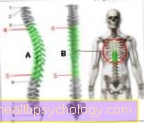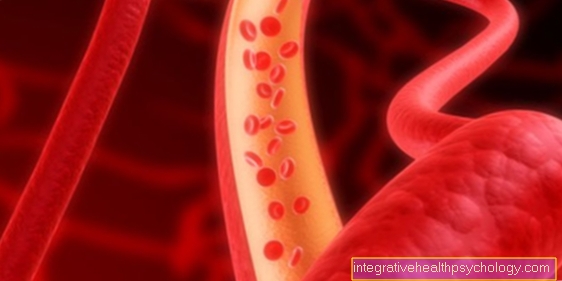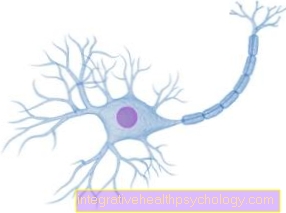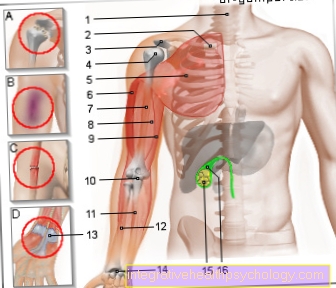How can I best lower my systole?
introduction
In the context of our heart action, we distinguish between two phases: systole and diastole. During the systole, also called the tension phase, the heart pumps blood into the circulation and in the diastole it fills up again. Both phases of the heart generate different pressure values: systolic and diastolic pressure. Ideally, the systolic blood pressure of an adult is between 100 and 140 mmHg (“first value”) and the diastolic blood pressure between 60 and 90 mmHg (“second value”).
With blood pressure values of> 140 mmHg systolic one speaks of high blood pressure. In Europe alone, around 30-45% of the population suffer from high blood pressure. Short- and long-term consequences can be strokes, heart attacks, kidney diseases and many other serious diseases.

Treatment of systolic hypertension
Nowadays, the indication, i.e. the need for therapy, arises not only from the level of blood pressure, but rather from the total risk of cardiovascular diseases (heart attack, stroke, heart failure, etc.). This risk is particularly high, for example, in the presence of very high blood pressure values (> 180 / 110mmHg) and / or existing clinical pictures of the cardiovascular system. In these cases, drug therapy is absolutely necessary to lower blood pressure and systole.
1. Weight normalization
Overweight patients should aim to reduce their weight. The “body mass index” (BMI) can serve as a rough guide. It is calculated using the formula BMI = body weight (kg) / (body height [m]) 2 and should be around 25 kg / m2.
2. Change of diet
If you suffer from high blood pressure and want to reduce your diastole, you should avoid eating salty food and you should not add salt to your food. Instead, it is advisable to use special dietary salt. A lot of fruit, vegetables, lettuce, nuts and as little animal fats as possible also have a beneficial effect on diastole.
3. Lifestyle change
Smoking and excessive alcohol consumption promote the development of high blood pressure. You should therefore stop smoking and consume as little alcohol as possible. Coffee consumption can also have negative effects on diastolic blood pressure. Relaxation training and avoidance of stress are also helpful.
4. Sports
Regular endurance training (5-7 / week for at least 30 minutes) such as swimming, walking or running significantly reduces the risk of heart attacks and can have a decisive effect on lowering diastole.
Basically, by fully exhausting the measures mentioned, slightly increased blood pressure values (especially diastole) can be reduced in around 25% of cases. However, in most cases, changes in behavior alone do not replace medicinal blood pressure therapy, which is also absolutely necessary, especially in the case of high blood pressure values.
Read more on the topic: High blood pressure sports
Drug therapy for increased systole
There are numerous options for treating hypertension. The body can effectively increase blood pressure by mainly two substances: norepinephrine / adrenaline and angiotensin. By suppressing the effect of these two messenger substances, one can get the hypertension under control.
In principle, one can differentiate between a so-called “monotherapy” and a “combination therapy”. While only one drug is used in the former, two or more drugs are used in parallel with combination therapy. A total of five different substance classes are available. In the event of systolic hypertension alone, all of these remedies can ultimately be used. In practice, however, a combination of thiazides and calcium antagonists is the most popular.
- Thiazides: They are among the diuretic, i.e. dehydrating drugs, and they work in the kidneys. Thus, thiazides have an indirect antihypertensive effect. Well-known active ingredients are hydrochlorothiazide (HCT) or xipamide. Since the electrolytes (“salts”) in our body, especially potassium, can become unbalanced during therapy, regular blood tests must be carried out during therapy.
- ACE inhibitors and angiotensin receptor blockers: Active ingredients that end in -pril such as enalapril or ramipril belong to the ACE inhibitors, substances with the ending -sartan such as valsartan or candesartan belong to the angiotensin receptor blockers. Both classes lower blood pressure by intervening in the important renin-angiotensin-aldosterone system (RAAS), which regulates blood pressure, among other things, through complex control circuits. The crucial organs for this are the heart, lungs and kidneys. In particular, the ACE inhibitors are the drug of choice nowadays, as, according to the current state of research, they show the best effect in most patients.
- Calcium antagonists: They block calcium channels in the walls of arterial blood vessels, causing them to widen or expand. In this way, active ingredients such as amlodipine lower blood pressure.
- Beta blockers: For a long time, beta blockers (metoprolol, bisoprolol etc.) were considered the drug of choice for high blood pressure. However, the latest studies show that other drugs, such as ACE inhibitors, have an advantage and better protect patients from secondary diseases. However, beta blockers are still indispensable in certain cases of high blood pressure.
How dangerous is elevated systole?
Diseases of the heart and the vascular system have been the most common causes of death in the rich industrial nations, to which Germany belongs, for many years. First and foremost, myocardial infarction is to be mentioned, which is caused by a narrowing of the coronary arteries supplying the heart muscle. This narrowing is caused by an increase in connective tissue, the deposition of calcium in the vessel wall, and the formation of blood clots (Thrombi) at the bottleneck.
In addition to an unhealthy diet, low physical activity and stress, increased blood pressure, in particular increased systole, also plays a major role. Since atherosclerosis in turn favors the progression of high blood pressure, those affected quickly find themselves in a vicious circle of hypertension and vascular damage. The consequences of this are complex. In addition to a narrowing of the heart vessels and the resulting heart attack, vessels in the brain are also attacked. This can lead to strokes and promote the development of dementia. Likewise, in the course of the process, vessels of the kidneys and legs are damaged, which will cause kidney failure or pain in the legs. Apart from that, however, all organs will ultimately suffer from high blood pressure due to damage to their vessels.
In summary, increased systolic blood pressure is a disease that must be taken seriously and which, if left untreated, has increasingly serious consequences for the body. Treatment of increased systole should therefore definitely be undertaken and carried out consistently.
Concomitant symptoms of increased systolic blood pressure
Often those affected do not notice their high blood pressure until very late. Complaints can be:
- Early morning headache, especially around the back of the head
- dizziness
- tinnitus
- sleep disorders
- Nosebleeds
- nervousness
- Racing heart
- Shortness of breath
These symptoms may or may not appear. Many hypertension remain clinically normal and are only discovered when the blood pressure is measured by chance. Even if symptoms do occur, it can be assumed that the hypertension has been around for a while before it becomes symptomatic.
Unfortunately, the disease usually only appears through complications or emergencies, such as a stroke.
Diagnosis
The diagnosis is quite easy to determine with the help of a blood pressure monitor. For this a 24-hour measuring device that you can get from your doctor and carry with you for a day. This is used to check whether the blood pressure is constantly elevated regardless of the situation. Systolic values above 140mmHg require treatment.
High blood pressure is divided into three degrees of severity. Grade 1 has systolic values of 140-159mmHg, Grade 2 160-179mmHg and Grade 3 more than 180mmHg.
A recent study from the USA has shown that the mortality (mortality) decreases significantly if the blood pressure is lowered not only to below 140mmHg, but to 120mmHg.
Cause of high blood pressure
There are different forms of hypertension or high blood pressure, which differ in their origins. The most common is that primary or essential hypertensionwhose genesis has not yet been clarified. There are factors that are jointly responsible for the development of the disease, but they still do not fully explain the pathomechanism. This applies in 90% of the cases, so that no specific cause for the high blood pressure can be found. At this primary hypertension Various factors such as obesity, increasing age, stress, diabetes or alcohol consumption play a role.
But what happens in our body to make it happen at all? On the one hand, blood vessels lose their elasticity in the course of our lives, become more rigid and show damage and injuries. The heart has to exert greater pressure in order to pump blood through the body against the increasing resistance. On the other hand, the blood volume, which our heart has to transport with each beat, increases due to various causes. This causes the blood to flow faster, which leads to an increase in blood pressure.
On the other hand, it is assumed that the body's own mechanisms for increasing blood pressure stimulate each other more and more and the kidney, which regulates the blood pressure, accepts higher values than the original setpoint.
Less common, but the better understood form of high blood pressure is this secondary hypertension. Secondary means that the causal problem lies in another organ and secondary causes high blood pressure. This can be, for example, renal artery stenosis or an endocrine disorder (affecting the hormonal balance) such as an overactive thyroid or hormone-producing tumors that raise blood pressure. An example of this is pheochromocytoma, a tumor of the adrenal medulla that produces large amounts of adrenaline.
Read more on the topic: high blood pressure
forecast
Untreated high blood pressure damages the cardiovascular system in the long term. Hypertension promotes calcification of the arteries, which significantly increases the risk of heart attack, stroke and PAD (peripheral arterial disease). Since the heart has to constantly pump against a pressure that is too high, it initially enlarges, but is permanently damaged and there is a risk of a Heart failure increases dramatically. A derailment of the blood pressure (> 200mmHg) even causes one medical emergency because there is a great risk that the cerebral arteries cannot withstand the pressure and rupture.
A large and often fatal cerebral hemorrhage can result. It is therefore important to check your blood pressure regularly and to take medication as quickly as possible if hypertension is discovered. Even if you do not necessarily feel something of the high blood pressure yourself, it is important to take the medication regularly, because the secondary diseases are serious. Even a blood pressure of 150mmHg, 10mmHg above the target value, reduces life expectancy by 10 years. Regular and continuous medication can significantly reduce the risk of cardiovascular disease, as there are a number of good medications available in this area.
prophylaxis
Since the hypertension is genetically determined to a considerable extent, it is not always possible to prevent the development of high blood pressure. However, certain risk factors such as smoking, obesity, lack of exercise, alcohol, an unhealthy high-fat diet and excessive salt consumption can be eliminated by adopting a suitable lifestyle. Because in the vast majority of cases, these behaviors lead to high blood pressure and reduce life expectancy by many years, even though they could actually be avoided.
Physiological basics
The basic pressure that prevails in the vessels during the filling phase of the heart is called diastolic blood pressure. It is around 80mmHg. The systolic pressure is higher than the diastolic (about 120mmHg) because the ejected blood has to be pumped against the base pressure. The systolic pressure is mainly dependent on the so-called Afterload. This is the pressure in the arterial system against which the heart has to pump. The higher this pressure, the more force the heart has to exert to convey the blood to the periphery.
The pressure is mainly caused by the vascular resistance of smaller arteries. The higher the resistance, the higher the pressure and the higher the afterload. Since this is a resistance high pressure, the vascular resistance of the arteries is the main point of attack of the systolic blood pressure reducer. It is also important to know how blood pressure is regulated, because this is where the medication intervenes.
The body can effectively increase blood pressure mainly through two substances: Norepinephrine / adrenaline and Angiotensin. Norepinephrine and adrenaline drive the heart by increasing the rate and pumping more volume. In addition, both substances lead to a constriction of the vessels and thus increase resistance and blood pressure. Angiotensin, on the other hand, leaves the heart alone, but also causes the blood vessels to constrict, thereby increasing arterial resistance and causing an increase in blood pressure.
Systole too high
If only the systolic value ("systole") is too high, one speaks of "isolated systolic hypertension". In severe cases, the systolic pressure can rise to> 180 mmHg, whereas the diastolic value remains at <90 mmHg. Typically older people and type 2 diabetics are particularly affected. In most cases of this form of high blood pressure there is advanced calcification of the blood vessels. Sometimes, however, the valve between the main artery and the left ventricle can also be “leaky” - the doctor then speaks of aortic valve insufficiency.
The level of the systolic value is decisive for the risk of a stroke or coronary heart disease (CHD). If one also subtracts the diastolic from the systolic blood pressure value, one obtains the pulse pressure. If this is too high, the risk of heart failure (Heart failure) to fall ill. Put simply: the higher the systole, the worse the prognosis. It is therefore imperative that medication measures be taken in good time to lower the systole!
Read more on the topic: Systole too high





















.jpg)







